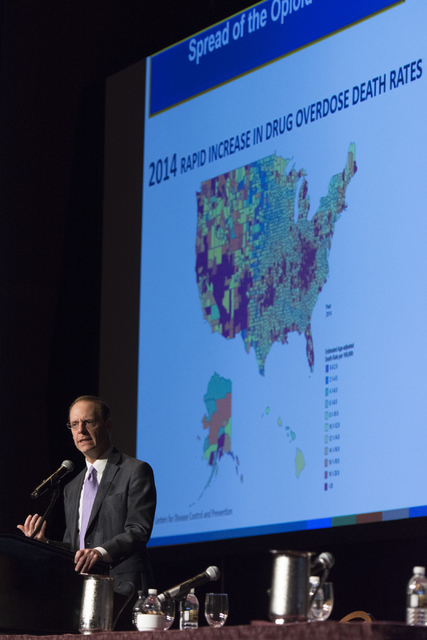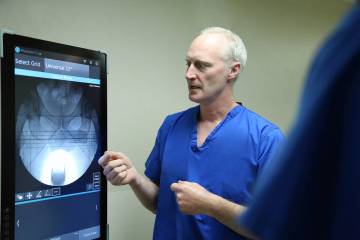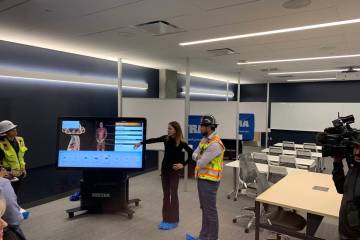

The state’s battle to fight opioid addiction is gaining ground. On April 27, Gov. Brian Sandoval announced Nevada has been notified by the U.S. Department of Health and Human Services that it will receive a $5.66 million grant to combat the problem of one overdose death a day.
Assembly Bill 474 was developed in the aftermath of Sandoval’s drug abuse summit, held last summer at the MGM Grand in Las Vegas.
The proposal from the governor’s office to combat opioid abuse would make changes dealing with the reporting of drug overdoses and would establish prescribing protocols for health care providers prescribing controlled substances for the treatment of pain.
A potential flashpoint that developed in 2016 between state lawmakers and physicians was averted as the bill has gone through the draft process. Doctors had been concerned that they would be unfairly targeted criminally or with the potential loss of their license for prescribing opiates for pain if the patient later develops an addiction or overdoses.
Catherine O’Mara, executive director of the Nevada State Medical Association, said the physician’s group was neutral initially over AB474 but is now supporting it after concerns were addressed.
One of those concerns was providing more clarity that patients who needed medication for chronic pain would still have access to it, O’Mara said. Another dealing with the suspension of a medical license for overprescribing could not be done without a hearing requiring due process, she said.
The bill is part of a multiprong effort to deal with the opioid abuse problem.
During the 2015 Nevada legislative session, Sandoval signed into law Senate Bill 459, which reduces potential criminal penalties for people who report drug overdoses and also makes it easier for people to access the non-addictive drug naloxone, which can help reverse opioid overdoses. The bill also requires doctors to do more to monitor a patient’s prescription history.
The grant will be used to take action on many of the recommendations from the governor’s opioid summit in 2016, according to Dr. Stephanie Woodard, senior adviser on behavioral health for the Nevada Department of Health. Among the priorities for funding are the expansion of prevention and treatment programs, increased access to naloxone to reduce overdose deaths, and education for prescribers on the implementation of medication-assisted treatment, she said.
“This grant funding is an invaluable opportunity to turn the tide and save lives,” Woodard said.
Daniel Burkhead, founder of Innovative Pain Care Center and co-chair of the Physicians Opioid Task Force that made recommendations to lawmakers on how to address the prescription drug problem, said Sandoval’s bill is a “reasonable approach” to make a first step toward curtailing the opioid epidemic in Nevada.
“It’s very challenging to come up with legislation that doesn’t overextend itself into the way a doctor practices,” Burkhead said. “It’s very important by the same token to have something in place that makes physicians recognize some of the significance of the prescriptions they are writing. This bill strikes a nice balance between those two issues.”
The way the bill is structured is that there are triggers if a physician’s prescribes medications above certain levels that give patients more than what they need, Burkhead said. That prevents the drugs from ending up on the streets, he said.
“That allows the physician to see what they might otherwise not have seen and gives them the capability of changing their prescribing,” Burkhead said. “By no means do I think that the majority of physicians are intentionally prescribing more than they need to. I think that would be a small minority. In a busy practice, a physician can get caught up trying to get through the day and maximizing efficiencies and not notice the amount they’re prescribing to a given patient.”
Physicians will use advisories from the Centers for Disease Control and Prevention on the amount of opiates patients should be prescribed, Burkhead said. At the same time, medical boards have the ability to take a look at what physicians are prescribing and how that compares to their peers, Burkhead said. If they’re in the top 5 percent of their subspecialty, the physicians can be notified, not in a punitive way, but in a constructive way, he said.
“I hope the bill makes a big difference in allowing physicians to be more mindful of what they’re prescribing and be judicious in the use of opioid medication so they can cut down on the opioids in the street,” Burkhead said.
Not only is there concern that those given painkillers can develop an addiction that leads to heroin use, but that teenagers can raid the medicine cabinets of their parents and grandparents and get addicted as well from excess opioid prescriptions.
“I don’t think this will make a difference in two years, but over the next decade I hope we see fewer and fewer young people having access to prescription opiates and will stop that pipeline,” Burkhead said.






